Let’s combine math and art to create a beautiful geometric art lesson inspired by Islamic art. We’ll be learning about symmetry and creating pictures that include squares, triangles, and repeating patterns.
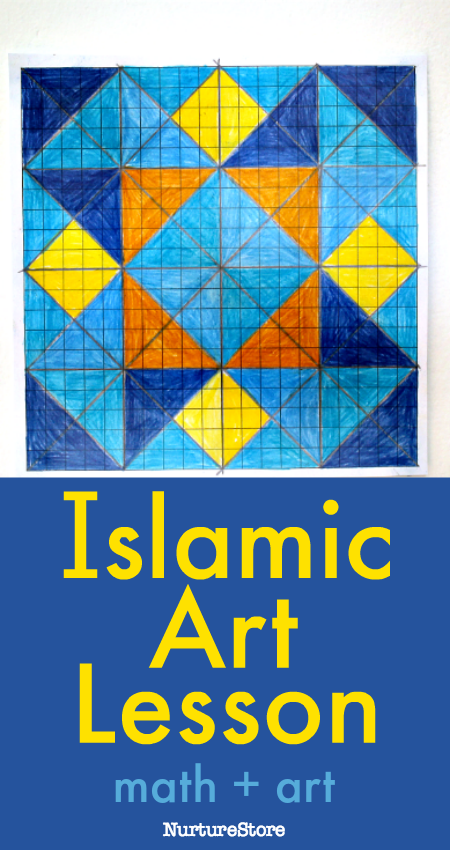
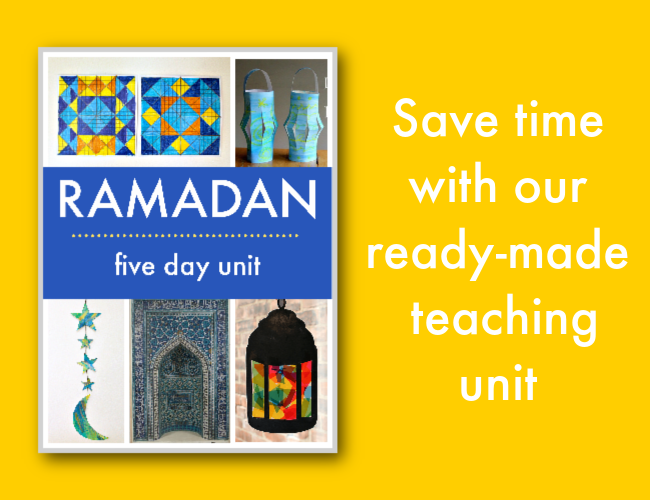
Save time with our ready-made Ramadan teaching unit
For the best Ramadan lesson ideas, save time and get our ready-made Ramadan teaching unit from our Play Academy. Our ramadan Unit is part of the Play Academy’s Festivals curriculum pathway and in it your children can:
- learn about Ramadan: what it is and how it is observed
- make Arabic-inspired paper lanterns
- play card games using Ramadan-themed playing cards
- create geometric Islamic art
- make a crescent moon and stars craft
- bonus printables include Islamic art grid for the math and art project, a lantern template, a mobile template, Ramadan word bank cards for vocabulary building and a Ramadan placemat for an iftar meal
- plus over 300 more individual lesson plans in 50 ready-made teaching units so you can easily teach an engaging and successful program that includes math, literacy, science, art, and more, all year round, year after year. Everything is planned for you and easy to find, saving you so much time.
Download your Ramadan Unit here
Come and join our popular Play Academy community and never have to lesson plan again! Join here and download your first ready-made unit today.
Islamic geometric art lesson for children
In this Islamic geometric art lesson you can learn about Islamic art and make geometric designs to explore shapes, patterns and symmetry.
Combining math and art
It’s so important to combine math and art. When we work across the curriculum it allows us to go broader and deeper with our learning.
We get to make connections between ideas, just as we learn in the real-world. Our understanding is more relevant and our learning is longer-lasting.
Working across math and art draws children in to a hands-on, visual lesson that engages those who love art and those who are fascinated by math.
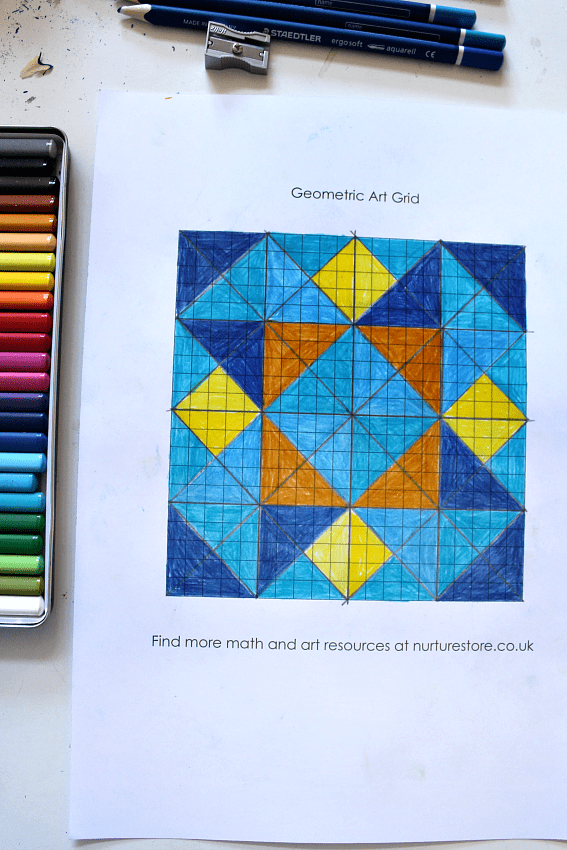
Geometric tiles inspired by Islamic art
In this lesson we will create geometric tiles inspired by Islamic art. We will:
:: learn about Islamic art and famous mosques around the world
:: learn about symmetry, exploring both linear symmetry and radial symmetry
:: develop our understanding of geometry, exploring the properties of squares, triangles, and other shapes
:: work with repeating patterns
:: create our own geometric art inspired by Islamic tiles
:: use a printable grid and rulers to create art – with the option to include a drawing compass
Materials needed
:: square grid guide (see below for details on how to get the printable in our ready-made Ramadan unit)
:: pencil
:: ruler
:: coloured pencils
:: drawing compass (optional)
You can adapt this lesson to suit your child. Younger children may enjoy looking at the pictures of mosques and the tiles, and then like to create their own picture from squares and triangles cut out from coloured card.
With older children you can choose to just focus on linear symmetry, or introduce radial symmetry too.
Some children may want to work with just a ruler, other children may like the challenge of incorporating a drawing compass.
Match the level of the lesson to your child’s interest and skill.
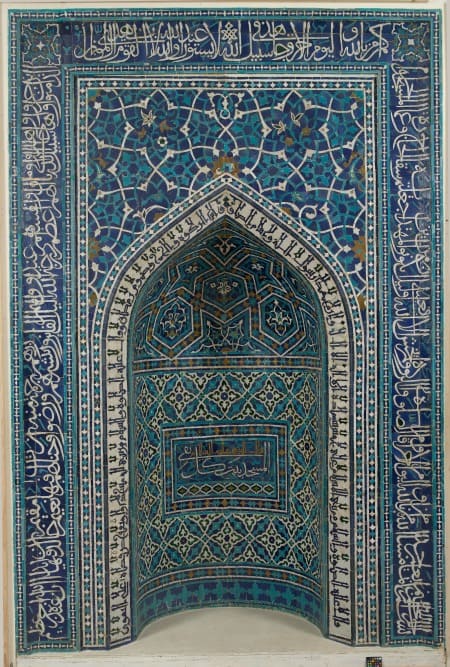
(Prayer Niche), A.H. 755/A.D. 1354–55, From Iran
Photographs from The Met are used with permission as they are in the public domain.
An introduction to Islamic art
Islamic art traditionally features geometric designs, using shapes such as squares, rectangles, triangles, and circles. It also includes many repeating patterns.
Traditional colours that are often see in Islamic designs include shades of blue and gold.
Calligraphy – artistic writing – is also an important element of Islamic art.
A mosque is a Muslim place of worship, and you will often see geometric art included in their design, with carpets, rugs, and tiled walls featuring these symmetrical shapes and repeating patterns.
Circles are used as they are unending – to represent how Allah (God) is infinite.
Repeating patterns show how one small element is part of a universal whole.
One tiny triangle is part of a huge pattern, just as one person is part of the universe, all created by God.
The Sheikh Lotfollah Mosque
The Sheikh Lotfollah Mosque in Iran is one of the most famous mosques in the world.
It was built between 1603 and 1619.
Compared to many other mosques the shape of the mosque is fairly simple, but it is filled with the most beautiful, complex decoration, both inside and on the outside walls.
One special feature is the peacock that can be seen at certain times by looking up at the inside of the dome. The sun’s rays flood in to create the image of a peacock’s body, with the tiles of the dome creating the feathers of the peacock’s tail.
You can see a photograph of it here.
You can see more examples of Islamic tiles and mosque designs on my Pinterest board.
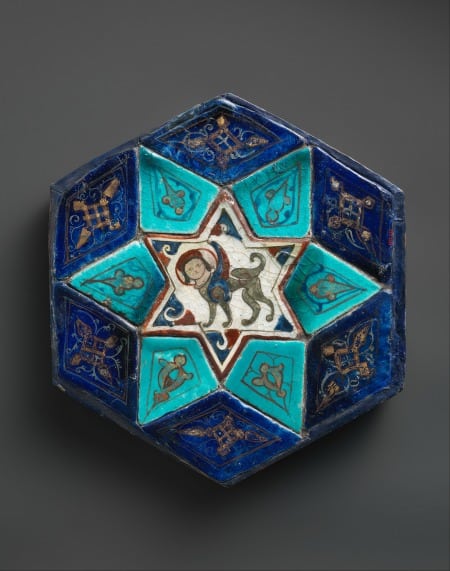
Tile Ensemble with Sphinx, ca. 1160s–70s, From Turkey
Photographs from The Met are used with permission as they are in the public domain.
What is symmetry?
Symmetry is a similarity or balance between different parts of something.
People, animals, and plants can be symmetrical in some ways.
Think about your body. Imagine drawing a line from the top of your head all the way down to the floor.
Then think about what your body looks like on either side of that line. One side is more or less the exact same as the other: an arm on each side, a leg on each side, matching ears, matching eyes. Your body is symmetrical.
Then think of the face of a cat, and imagine a line from the top middle of the cat’s head running down to its chin. Can you see symmetry here too?
The cat’s face is balanced on each side of that line: two ears, two eyes, two nostrils, two sets of whiskers. It’s symmetrical.
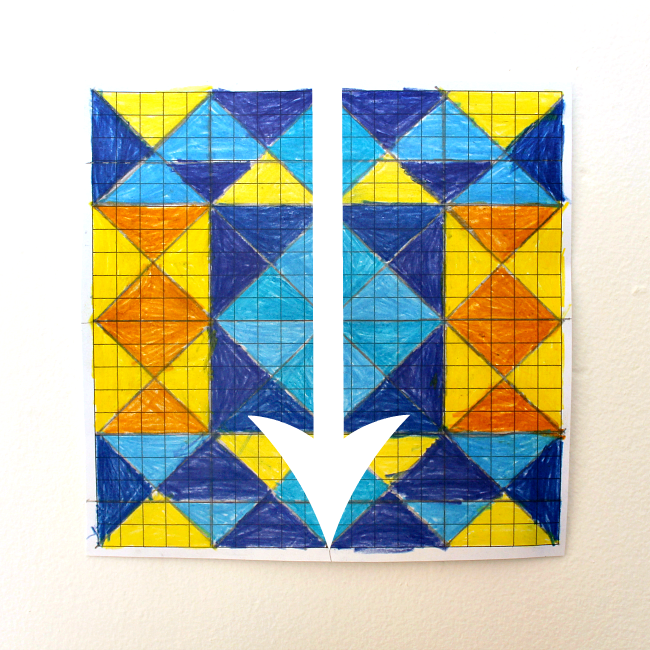
Linear Symmetry
Imagine a line draw down the centre of this geometric tile.
Are the two sides balanced?
Are they symmetrical?
This kind of symmetry, along a line, is called linear symmetry. It’s also referred to as mirror symmetry or lateral symmetry.

Radial Symmetry
Radial symmetry is symmetry around a central axis.
Take a look at the coloured-in squares in the tile in the photograph above.
Imagine a line coming out from the very centre of the tile to the coloured-in square (arrow number 1).
Imagine rotating that first coloured-in square around the tile to place number two, then to place number three, then place number four.
It would match its position at each turn.
Notice how each gold section of the coloured-in square is always at the bottom as the squared rotate on the central point.
Notice how the dark blue triangle is always on the left.
This is rotational symmetry.
Repeating patterns
Have a look at the shapes and colours in the tiles too. Can you see that certain colours repeat in order?
Sometimes they repeat along a line, and sometimes they repeat within a shape.
Perhaps you can include repeating patterns when you create your own tile?
How to create your own geometric tile art
Print off the geometric art grid from the ready-made Ramadan unit (see below) and get a pencil and ruler.
We’ll begin by dividing our tile into shapes, and then we will colour it in.
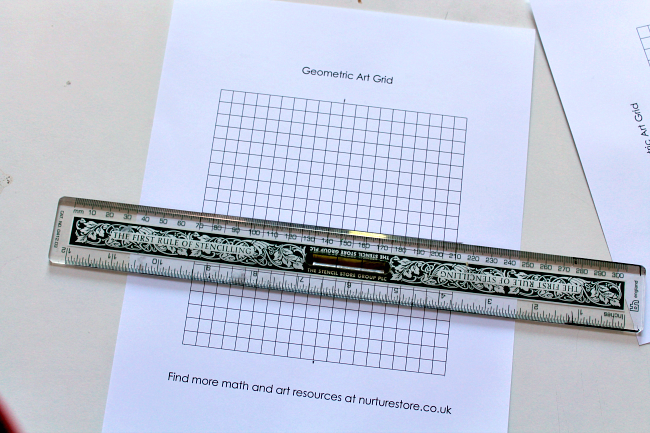
Start by finding the centre of your square. Count the grid lines to find the middle one and draw a line across the very middle of your square
Mark both the vertical (up and down) line and the horizontal (across left to right) line.
What shapes can you see in your square now?

The draw in the diagonal lines, from corner to corner.
Notice how they also pass through the very centre of the square.
What shapes can you see in your square now?
How many triangles have you created? (Hint: it’s more than 8!)
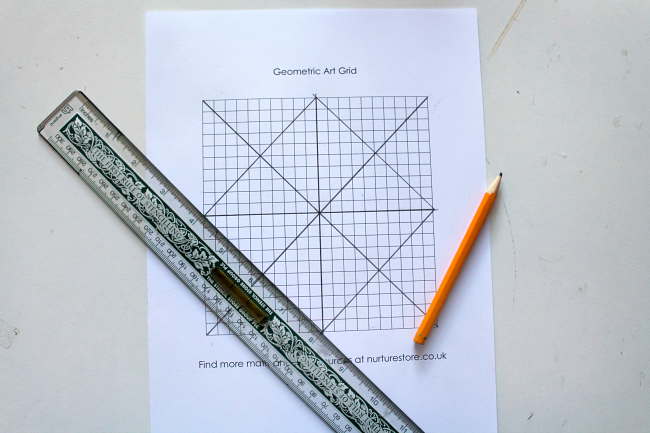
Now you can begin to add extra lines on your tile to create your design.
Use your ruler to join points on your grid to make more shapes within your tile.
Think about the different squares, rectangles, and triangles you can make.
Keep your tile symmetrical and think about including repeating patterns.
You might like to join up the ends of your middle lines to create a smaller square within your tile. (see above)
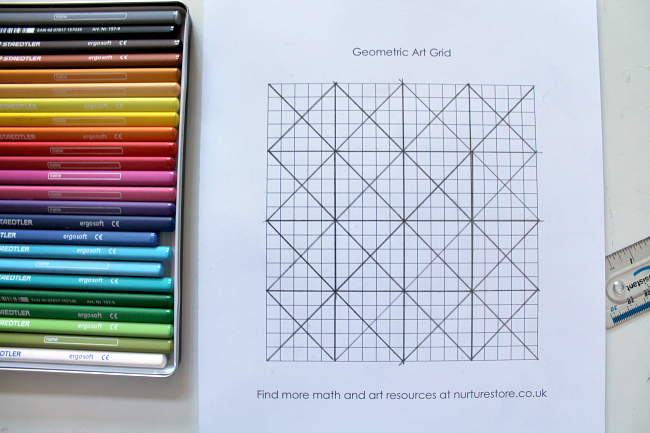
And then add more parallel lines to fill your tile.
You could also use a drawing compass to create a circle, placing the point of the compass at the centre of your square.
It’s up to you how detailed you make your tile.

Once you have drawn out a design that you are pleased with, you can use coloured pencils to colour it in.
You might like to use a scheme of blues and gold, inspired by the art in the mosques.
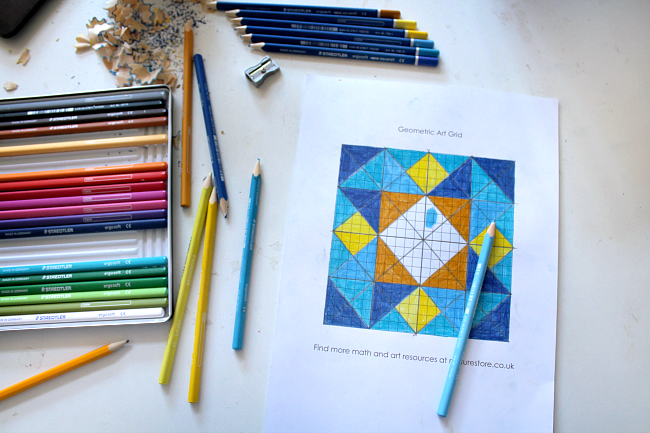
Use the ideas of symmetry when you colour in, placing colours within certain areas to give your design a balanced design.
You might like to make one half of your tile exactly match the other, using linear symmetry.
You might like to try and include an element of radial symmetry too.
Save time and get your ready-made Ramadan unit!
Yes, you can do all the planning yourself if you want to, or you can head straight to our Play Academy and download our ready-made Ramadan unit. That sounds like a better idea!
You’ll get a set of lesson plans to teach your children about Ramadan: a lesson plan to learn about the festival and how it is observed, a math-meets-art geometric Islamic art lesson, an arts and craft activity to make Arabic-inspired paper lanterns, play card games using printable Ramadan-themed playing cards, and a art and craft activity to make a crescent moon and stars mobile. Plus you’ll get a great set of useful printables to make your teaching even easier.
Come and join the Play Academy to get this and over 50 more ready-made teaching units, so you can easily teach an engaging and successful program that includes math, literacy, science, art, and more, all year round, year after year.



Im taking some kids to the Alhambra on Friday, this is perfect for inspiring some activities afterwards. Thank you
Oh enjoy, Bridie! It’s such a beautiful place.
Thanks!